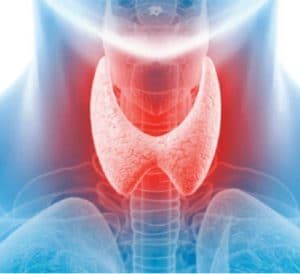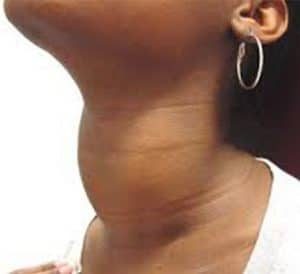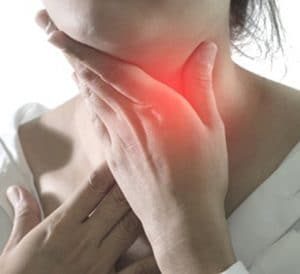Thyroid cancer
Abnormal growth of the thyroid cells, which located below the Adam’s apple in the front of the neck.
.

Modifiable risk factors
- A diet low in iodine: Follicular thyroid cancers are more common in areas of the world where people’s diets are low in iodine.
- Radiation exposure: Sources of such radiation include (certain medical treatments and radiation fallout from power plant accidents or nuclear weapons), Having had head or neck radiation treatments in childhood.
Non-modifiable risk factors
- Age: can occur at any age, but the risk peaks earlier for women (who are most often in their 40s or 50s when diagnosed) than for men (who are usually in their 60s or 70s)
- Gender: occur about 3 times more often in women than in men
- Family history: Having a first-degree relative (parent, brother, sister, or child) with thyroid cancer, even without a known inherited syndrome in the family, increases your risk of thyroid cancer.
- A lump in the neck, sometimes growing quickly
- Swelling in the neck
- Pain in the front of the neck, sometimes going up to the ears
- Hoarseness or other voice changes that do not go away
- Trouble swallowing
- Trouble breathing
- A persistent cough that is not due to a cold

- Reduce exposure to radiation and environmental pollution
- Genetic testing for patients who have a family history of the disease.
- Preventive surgery for people with a family history of thyroid cancer.
- Healthy diet high iodine (milk, seafood, iodized salt, tuna, egg, yogurt, bananas, strawberries, corn, cranberries, green beans
Recommend that people examine their necks twice a year to look and feel for any growths or lumps.
- Blood tests to detect any abnormal levels (very high or very low) of thyroid hormone (TSH)
- Thyroid Ultrasound
- Radiographic scanning of thyroid gland

- + Risk factors
-
Modifiable risk factors
- A diet low in iodine: Follicular thyroid cancers are more common in areas of the world where people’s diets are low in iodine.
- Radiation exposure: Sources of such radiation include (certain medical treatments and radiation fallout from power plant accidents or nuclear weapons), Having had head or neck radiation treatments in childhood.
Non-modifiable risk factors
- Age: can occur at any age, but the risk peaks earlier for women (who are most often in their 40s or 50s when diagnosed) than for men (who are usually in their 60s or 70s)
- Gender: occur about 3 times more often in women than in men
- Family history: Having a first-degree relative (parent, brother, sister, or child) with thyroid cancer, even without a known inherited syndrome in the family, increases your risk of thyroid cancer.
- + Early signs and symptoms
-
- A lump in the neck, sometimes growing quickly
- Swelling in the neck
- Pain in the front of the neck, sometimes going up to the ears
- Hoarseness or other voice changes that do not go away
- Trouble swallowing
- Trouble breathing
- A persistent cough that is not due to a cold

- + Prevention
-
- Reduce exposure to radiation and environmental pollution
- Genetic testing for patients who have a family history of the disease.
- Preventive surgery for people with a family history of thyroid cancer.
- Healthy diet high iodine (milk, seafood, iodized salt, tuna, egg, yogurt, bananas, strawberries, corn, cranberries, green beans
- + Prevention
-
Recommend that people examine their necks twice a year to look and feel for any growths or lumps.
- Blood tests to detect any abnormal levels (very high or very low) of thyroid hormone (TSH)
- Thyroid Ultrasound
- Radiographic scanning of thyroid gland

